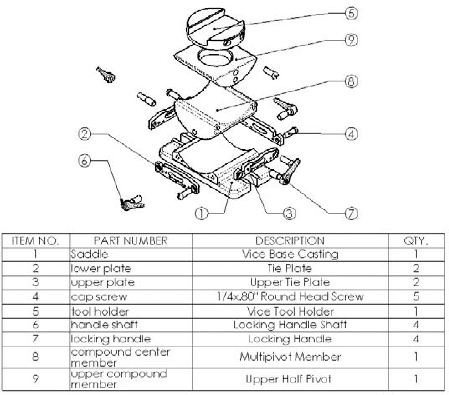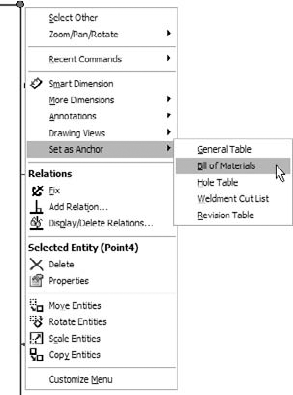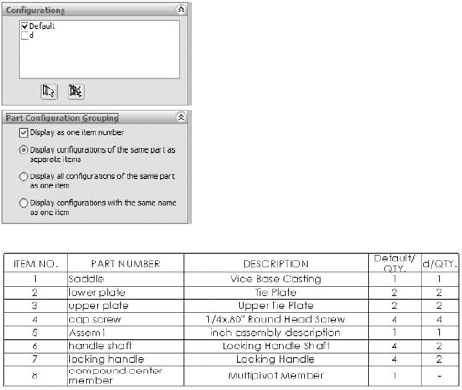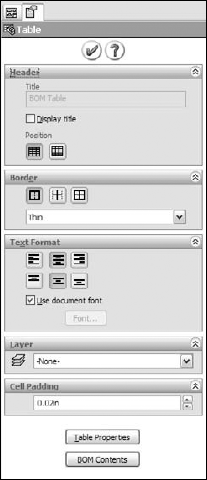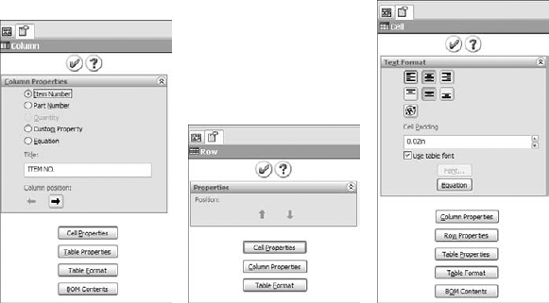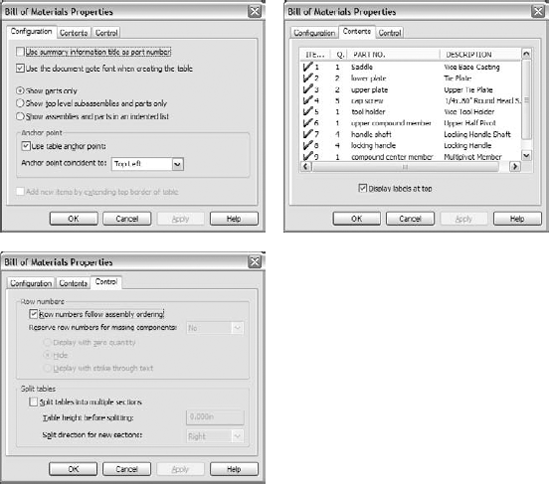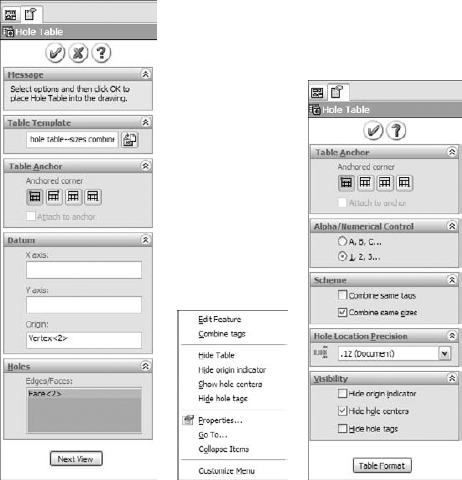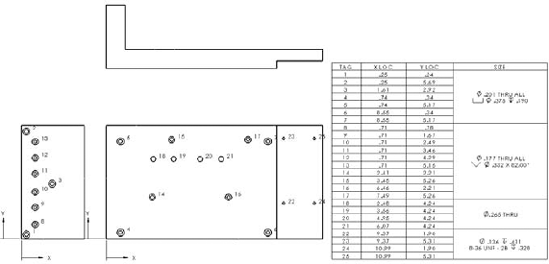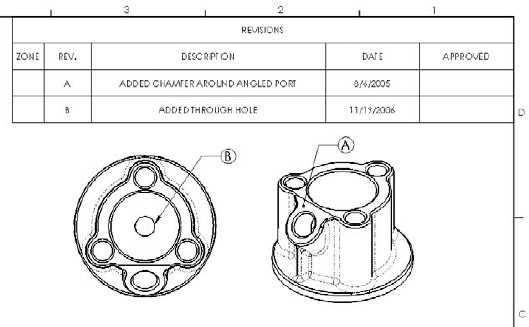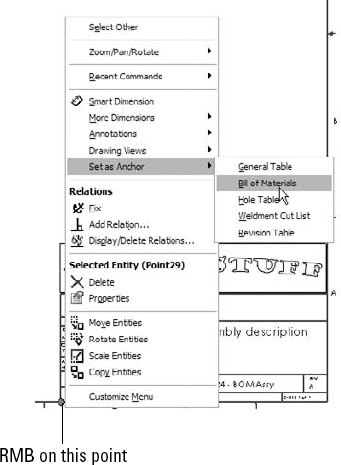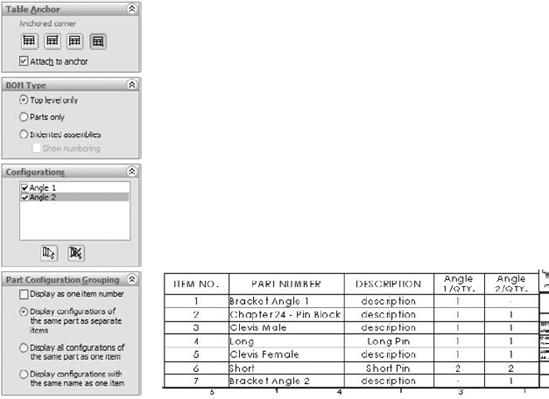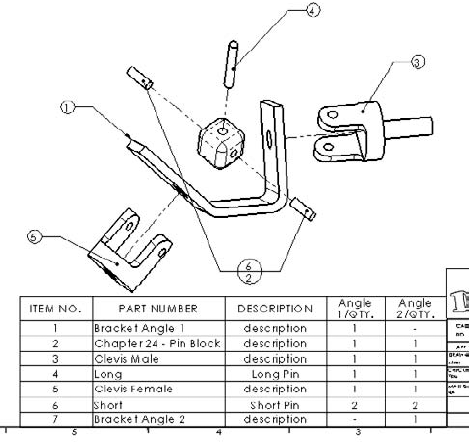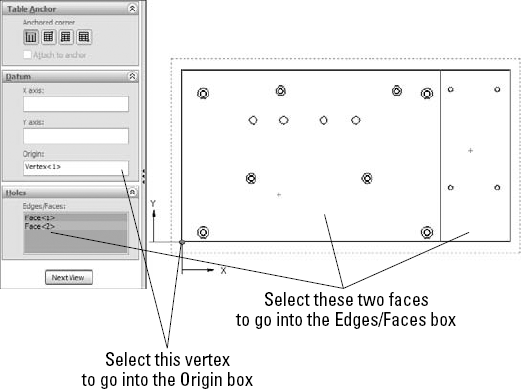IN THIS CHAPTER
Driving the Bill of Materials
Using Design Tables
Using Hole Tables
Using Revision Tables
Using Gauge Tables and Bend Tables
Using Weldment Cut Lists
Using General Tables
Tutorial: Using BOMs
Tutorial: Using Hole Tables
Tutorial: Using Revision Tables
SolidWorks enables you to place several types of tables on drawings, such as the Bill of Materials, or BOM. Design Tables that are used in parts and assemblies can also be shown on the drawing to create a tabulated type drawing. Hole Tables enable you to chart the center locations and sizes of holes for easy access to manufacturing data. Revision Tables can work with PDMWorks or by themselves to help you document the revision history of a drawing. General Tables are also available for any specialized items that are not covered by the other table types.
The Bill of Materials, or BOM, is one of the most frequently used types of tables that are available in SolidWorks. BOMs are intended for use with assemblies, but can also be used with individual parts for specialized applications. The types of information that you can expect to see on a BOM are item number, filename, quantity used, description, and any other custom property that you would like to add to it. A typical BOM is shown in Figure 24.1.
BOMs are made in one of two ways. The default BOM is made from a special SolidWorks table, while an Excel-based BOM is driven by Excel. While Excel has advantages and disadvantages, many users appear to prefer the default BOM. The reason for this preference is that little is perceived to be given up, except for the stability (crash-worthiness) compared to Excel and the options to keep manual edits.
If you plan to use anything other than the standard SolidWorks BOM templates, then you need to make your own BOM templates. If you plan to create either Excel- or SolidWorks table-based templates, then you must choose one of them.
Like other types of data, the SolidWorks table-driven BOM starts from a template. The BOM in Figure 24.1 was created from the default BOM template. When a BOM is initiated, you can select the template in the Table Template panel at the top of the PropertyManager, as shown in Figure 24.2.
Table-based BOM templates are created in much the same way that other templates are created:
Specify the settings
Delete the document-specific data
Save the template
To save the template, right-click the BOM and select Save As. In the Files of Type drop-down list, select Template (*.sldbomtbt, which stands for "SolidWorks Bill Of Materials Table Template"). Any of the settings, additional columns, links to properties, and so on are saved to the template, and reused when you create a new template from it.
Note
Put the BOM template in your library area outside of the SolidWorks installation folder. Then identify the path in the Tools
A table anchor locks a corner of the table to a selected point on the format. If no point is selected in the format, then the table is placed at a corner of the sheet. To specify a point in the format to act as the anchor, you must be editing the format (RMB click the sheet and select Edit Sheet Format). Then right-click a sketch endpoint in the format, select Set As Anchor, and specify which type of table the anchor is for. You can set different anchor locations for different types of tables. Figure 24.3 shows the selection and menus for this option.
Tip
You should save the format and drawing template with these table anchors specified so that you do not need to re-specify them for each new document.
As the name suggests, the Top Level Only BOM only shows components on the top level. It treats subassemblies as a single entry. As a result, if the top-level assembly shown on the drawing is made up of five subassemblies and two individual parts, and you select the Top Level Only option, then only seven items are shown in the BOM.
The Parts Only BOM ignores subassembly structure, and only displays parts in an unindented list.
The Indented Assemblies BOM shows the parts of subassemblies in an indented list under the name of the subassembly. This is the most complete list of SolidWorks documents used because it includes all parts and assemblies.
The Show Numbering option for indented assemblies is only activated after the Indented Assemblies option is checked, and you have placed the table. When you use this option, it causes subassembly parts to be numbered with an X.Y number system. For example, if item number 4 is a subassembly, and it has three parts, then those parts receive the item numbers 4.1, 4.2, and 4.3.
The Configurations panel of the BOM PropertyManager displays slightly differently for Top Level Only BOMs compared to the other types. The Top Level Only BOM type enables the option to show multiple assembly configs and display the quantities for top-level components in separate columns, as shown in Figure 24.4. This figure shows that the configuration named "D" has some suppressed parts, including some parts that are now not used in the "D" configuration, and that therefore have a zero quantity. Notice the available options for dealing with zero-quantity parts.
When you are making changes to a model, parts are often either suppressed or deleted altogether. Some company documentation standards require that parts that are removed from a Bill of Materials remain on the bill, and display with strikethrough formatting, although this may be a relic from days gone by when it was more difficult to remove items from hand drawings.
The Zero Quantity Display settings are only used for configurations where some components are not used in some configurations. The three options that are available are:
Quantity Of Dash: Substitutes a dash for the quantity value
Quantity Of Zero: Uses a zero for the quantity value
Blank: Quantity value is blank
Item numbers for components listed in the BOM can start at a specific number and be given a particular interval. The Do Not Change Item Numbers option means that even when rows are reordered, item numbers stay with their original components.
The Follow Assembly Order option, which is also available through the RMB menu, means that the order of the components in the BOM follows the order of the components in the Assembly FeatureManager. If the order is changed in the assembly, it also updates in the drawing.
The BOM Contents button at the bottom of the Bill of Materials PropertyManager opens the dialog box shown in Figure 24.5. This dialog box enables you to reorder as well as hide or show rows of the BOM. If you created the BOM using the Indented Assemblies option, then assemblies can also be expanded and collapsed from this interface.
You can also group and ungroup components in this interface, to reorder them as a group that is handled differently from the way that a subassembly is handled.
Below the BOM Contents button is a button that allows you to access the Table PropertyManager. The Table PropertyManager interface is shown in Figure 24.6. The options in this interface are self-explanatory, and help you to visually format the table.
If you are already familiar with formatting an Excel-based BOM, then it may take some getting used to formatting the SolidWorks table-based BOM. Figures 24.7 and 24.8 show some of the cursor feedback and selection methods for selecting a column, a row, and a single cell, and moving the entire table.
To move the table, click above and to the left of the upper-left corner and drag the table to a new location. When the table is selected, a border appears around the table that is not normally visible, and is not printed with the drawing. You can change the properties of a row or a column by selecting just outside of the row or column to the top or the left.
You can establish spacing and width of rows or columns by dragging with the split cursor shown in Figure 24.7 or by typing a value for the column width in the Column Properties panel.
To add a column, right-click near where you want to add the column, and select Insert. Then select whether you are adding a row or a column, and whether you are placing it above or below where you right-clicked.
If the column goes in the wrong location, then you can move it by selecting the column and using the arrows in the Column Properties panel to move it left or right.
The next thing you will want to do with a column is to assign what kind of data goes into the column. You can use a custom property such as Part Weight or Vendor, as shown in the Column Properties panel in Figure 24.8. The Title box in the panel enables you to put a header at the top of the column. You can also use equations in the SolidWorks table-driven BOM.
If the Custom Property option is checked in the Column Properties panel, then a custom property can be selected to populate the cells of that column for each part in the assembly.
Note
If you create a BOM with the columns and properties that you like, then you can save it to a template as described earlier in this chapter.
You can insert a Design Table into a drawing by selecting Insert
Design Tables that are displayed in this way are often formatted visually to some extent. It is necessary to hide columns and rows unless you want the dimension or feature name syntax to display on the drawing as well as the values. Extra columns and rows are often added to make the design table readable. The image to the left in Figure 24.10 shows a design table that is formatted to be placed on a drawing. The image to the right shows the same design table with all of the information shown. The first column and the first row are hidden to make the table more readable on the drawing, and the second column and second row use the $user_notes header to format the names.
Figure 24.11 shows the drawing with the table inserted. To display the table properly, you have to edit the table in the window of the parent document and adjust the border of the table to be exactly how you want it to appear on the drawing. The adjusted table is shown in Figure 24.11.
The labeled dimensions were created by simply making reference dimensions and overwriting the <DIM> value in the Dimension Text panel of the Dimension PropertyManager. If you would like to examine this data more closely, the drawing and part are included on the CD-ROM. The drawing is named Chapter 24 – DT.slddrw.
This drawing uses a part Design Table, but you can also place assembly Design Tables onto the drawing. This type of drawing is often called a tabulated drawing.
If you need to place something on your drawing such as a Design Table, but it does not appear that the Design Table is going to meet your needs, then you may want to simply copy the data out of the Design Table and recreate it in a static Excel spreadsheet. The Design Table that you place on the drawing updates if it is changed in the part or assembly, just like the drawing geometry, but you must manually update an Excel spreadsheet that is created from copied data. Again, you must answer the question about whether the automatic functions make up for the cost of setting them up to work for you. In many cases they do, but in other cases they require more work than they save.
Like other table types, Hole Tables can use templates. As with other templates, you should locate Hole Table templates in a library area outside of your local SolidWorks installation folder. You can then direct SolidWorks to this location using the path settings at Tools
Hole Tables use anchors in exactly the same way as BOMs. For more information, see the Table Anchors subsection in the Bill of Materials section earlier in this chapter.
You can find the options for hole tables at Tools
Figure 24.12 shows the PropertyManager for a hole table. Figure 24.13 shows the resulting Hole Table on a drawing with a part that contains holes. The table incorporates holes from multiple views, using a different zero reference for each view.
To initiate the Hole Table function, you must first select a view. You can access the Hole Table function through Insert
To specify the datum, either select an edge in each direction to serve as the zero mark for the X and Y directions, or select a vertex or point to serve as the Origin in both directions.
To select the holes to be included in the table, activate the Holes panel selection box, and either select the hole edges directly, or select the faces on which the holes are located. Once you place the table, you can add holes or change the datum information. To do this, use the RMB menu of the Hole Table entry in the Drawing FeatureManager, and select Edit Feature. The RMB menu is shown in the middle image of Figure 24.12. If you simply select a Hole Table that has already been created, the Properties interface displays, as shown in the top-right image. You can resize columns and rows in the same way as for BOM tables.
In the table in Figure 24.13, the Combine Same Sizes option is used, which causes several of the cells of the table to merge. If you use the Combine Same Tags option, then the hole locations are not displayed—only the hole callout description and the quantity appear. Figure 24.14 shows this arrangement.
You can control the hole callout description used in Figure 24.14 by using the file named calloutformat.txt, which is found in the langenglish subdirectory of the SolidWorks installation directory. Again, if you customize this file, then you should keep it in a library external to the installation directory and list it in the Tools
Figure 24.15 shows the Revision Table PropertyManager interface where you can create and control the settings for the table. You can find the default settings for Revision Tables at Tools
The image in the upper left of Figure 24.15 is the PropertyManager interface that displays when you initially create the Revision Table, and the rest of the Figure 24.15 images are for editing or adjusting the table. The properties for columns, rows, and cells can be controlled in much the same way as other table types.
You can initiate the Revision Table function through the menus or the Tables toolbar. However, this function simply creates the table, it does not populate it. You must set the table anchor in the format in order for the Table Anchor to work. Additional columns may be added or formatted to accept other data. Once you have created the columns or formatting, you can save the changes to a template, which is also available through the RMB menu.
You can add a revision to the table by right-clicking the table and selecting Revisions
Immediately after you have created the revision, if the option is enabled, you are prompted to place a balloon that contains the revision level to identify what has been changed. To finish placing symbols, you can press Esc or click the green check mark icon in the Confirmation Corner or the PropertyManager. When you are finished placing the balloons, you can fill in the description of the revision by double-clicking in the Description cell where you want to add text. Figure 24.16 shows a Revision Table with balloon symbols placed on the drawing.
Revision Tables work by creating a Revision custom property in the drawing document, and by incrementing this revision each time a revision is added to the table. Additional columns that are linked to custom properties can be added to Revision Tables and Revision Table templates.
Gauge Tables and Bend Tables are specific to sheet metal parts, and are covered in detail in Chapters 29 and 30.
The General Table uses the filename extension, *.sldtbt. It can be created without a template, as a simple block of four empty cells, or you can use a template that has a set of pre-created headers.
Rather than having tutorials for every table type, this chapter has tutorials only for the BOM, Hole Table, and Revision Table. The skills used with these types are transferable to the other types.
This tutorial guides you through the steps that are necessary to prepare an assembly for the drawing and BOM. Configurations and custom properties are used in this example. Remember that if a drawing view is cross-hatched and you cannot see the geometry, then you may have to press Ctrl+Q to rebuild it. Follow these steps:
Begin this tutorial with SolidWorks closed and Windows Explorer open.
If you have not already done so, create a folder for a library that is not in your SolidWorks installation folder. Call it D:Library or something similar. Make a folder inside this folder called Drawing Templates. Copy the file from the CD-ROM named inch B.drwdot to this new folder.
Launch SolidWorks and go to Tools

Open the assembly Chapter 24 – BOM Assy.sldasm from the CD-ROM.
Using the Make Drawing From Part/Assembly button, make a new drawing of the assembly from the drawing template.
Delete the isometric view, and in its place make a new drawing view using the named model view "exploded."
Edit the sheet format. Right-click the sketch point at the location indicated in Figure 24.17. In the pop-up menu that appears, select Set As Anchor and then select Bill of Materials.
Exit Edit Sheet Format mode by selecting Edit Sheet from the RMB menu.
Select the new view and click Insert

Click inside the exploded view, but off of any part geometry, and then select the Autoballoon tool from the Annotations toolbar. Toggle through the available options to see whether any of the possible autoballoon configurations meets your needs. If not, use the standard Balloon tool to select the part and place the balloon. This gives you more control over the attachment points and placement of the balloons.
Change the balloon for the short pin to be a circular split-line balloon (do this by clicking the balloon, and then switching the style in the PropertyManager). Notice that the quantity appears in the bottom of the balloon. The drawing view and the BOM should now look like Figure 24.19.
Notice that several of the parts use a default description of "description." Edit each of these parts by right-clicking the part's row in the BOM table and selecting Open <filename> from the menu. Change the custom property called Description in each part. Keep in mind that this may be handled differently for configured parts.
Note
New in SolidWorks 2007 is the ability to open a part directly from its entry in the BOM.
The Bracket part is listed twice using the configuration name because of the way the configurations are set up for the parts. To list the bracket only once using the filename, open the bracket, RMB click one of the configuration names in the ConfigurationManager, and select Properties. In the Bill of Materials Options panel, select Document Name from the drop-down list. Do this for the other configuration, as well.
Notice also that the Description field holds the configuration-specific custom property for Description, which is used in the BOM.
Toggle back to the drawing (using Ctrl+Tab), select anywhere on the BOM table, and then select Table Properties from the PropertyManager. Expand the Part Configuration Grouping panel, and select the Display All Configurations Of The Same Part As One Item option. This changes how the bracket displays, as well as the pins.
In this step, you will add a column to the BOM that calls on an existing custom property that is already in all of the parts. Place the cursor over the last column on the right and RMB click it. Select Insert

In the first drop-down selection box, select the Weight custom property. Click the green check mark icon to accept the changes.
The BOM with the additional column can be saved as a BOM template by right-clicking anywhere in the BOM and selecting Save As. You can then set the type to a BOM template, and the directory to the library location for BOM templates.
If you would like to compare your results against mine, the finished drawing is called Chapter 24 – BOM Tutorial Finished.slddrw.
This tutorial guides you through the creation and setting changes that are common in SolidWorks Hole Tables. The part for this tutorial is the part from which the figures for the section on Hole Tables were made. Follow these steps:
Create a new drawing from the template that was used for the BOM tutorial. If you have not done the BOM tutorial, then move the drawing template named inchB.drwdot from the Chapter 24 materials on the CD-ROM to your library location for drawing templates. Then create the drawing from the template.
Click the Model View button on the Drawings toolbar, and browse to the part named Chapter 24 - Hole Table Part.sldprt.
Place a Front view and project a Left view and an isometric view. Then press Esc to quit the command. Finally, delete the four predefined views.
There is not an anchor in this template for a Hole Table. If you would like to create one, this would be a good time to do so. Follow the steps in the BOM tutorial for specifying the anchor point.
From the Tables toolbar, click the Hole Table button.
Figure 24.21 shows a section of the Hole Table PropertyManager with the selections that you need to make for this Hole Table.
Once you have completed the selections, press the Next View button at the bottom of the PropertyManager, and make similar selections in the Left view. The holes for both views are added to a single Hole Table.
The table is created using the default settings established in Tools

Change the number of decimal places used in the Hole Table from two places to three. You can do this in the Table Properties window, in the Hole Location Precision panel.
Deselect the Hide Hole Centers option in the Visibility panel.
In this tutorial, you create a basic Revision Table, and make a template. Follow these steps:
Using a drawing that you completed in one of the previous tutorials, make sure that a Revision Table Anchor has been placed in the upper-right corner of the Sheet Format. You must edit the Sheet Format to do this by RMB clicking the point that you want to use for the anchor. Remember to select Edit Sheet from the RMB menu to exit Edit Sheet Format mode.
Note
Ideally, the anchors for all table types should be set in templates and formats, but here it is set up to ensure that you get some practice with creating the anchors.
Click the Revision Table button on the Tables toolbar. Be sure to select the upper-right corner that you want to be anchored, and select the Attach to Anchor option in the PropertyManager. Click the green check mark icon to accept the table. Figure 24.23 shows the initial stub of the Revision Table.
Tip
Drawing templates can be saved with the Revision Table stub if it also has a format. The revision table is not saved with the format because it has to go on the drawing sheet.
To initiate a new revision level in the Revision Table, RMB click the table and select Revisions

Depending on the default settings in Tools

Depending on your options settings, you may immediately be prompted to place a balloon that contains the new revision level. You can place balloons with or without leaders. The balloons are meant to indicate areas of the drawing that are affected by the revision. Press Esc or click the green check mark icon when you are finished placing the balloons.
Note
You may want to be careful using balloons on assembly drawings or other drawings that already have balloons that are used for other purposes. For this reason, it may be a good idea to use a distinctively shaped balloon for Revision Tables.
To add text to the Description field, simply double-click in the field and start typing. The text automatically wraps to fit the box.
Practice by adding a couple of revisions, balloons, and descriptions.
After you have added a couple of revisions, check the custom properties by going to File

Note
The number of revisions kept in the Revision Table is no longer an option as it was in previous releases, but in its place you can now control how revision tables interact with multiple sheets. For more information, see Appendix B.
You can add columns in the same way that they were added to the BOM. You can merge and unmerge cells, and link properties to cells. With the cursor over the last column (Approved), RMB click and select Insert

Save the template by right-clicking anywhere in the Revision Table and selecting Save As

SolidWorks enables you to work with both tables that are highly specialized for particular uses, and the General Table, which is available for any type of tabulated data. The most frequently used types are BOMs, Hole Tables, and Revision Tables. Design tables that drive part and assembly configurations can also be placed on a 2D drawing, but in these cases, some formatting is usually necessary to make the Design Table presentable and the information on it easy to read.
Other types of tables, such as Gauge and Bend tables and Weldment Cut Lists, are specialized for sheet metal and weldment parts, respectively, and are discussed in chapters that cover those topics.

